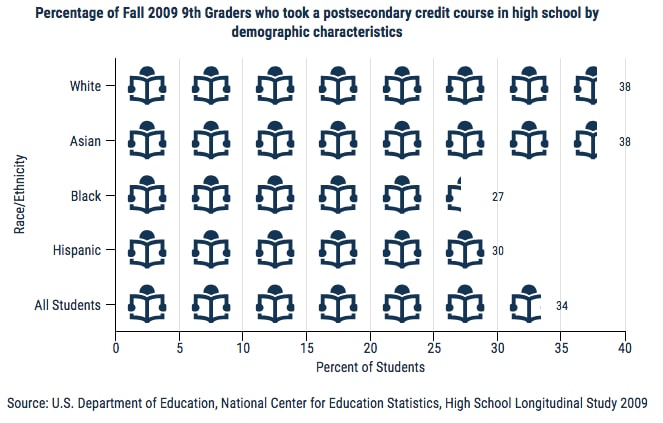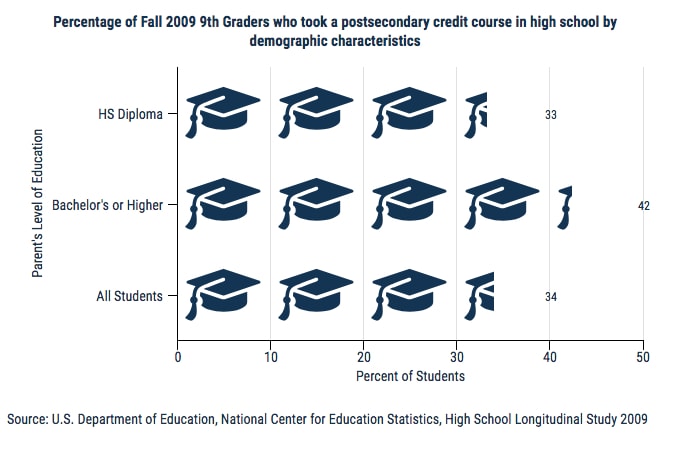Fostering Equity in Dual Enrollment

In my previous work at a local education agency and in higher education institutions, I had the opportunity to counsel staff and advise students on the benefit of participating in dual enrollment programs. As we reviewed state and district policies on dual enrollment programs, I learned a great deal about the variety of offerings available to students. Unfortunately, far too often there were significant barriers that stood in the way of students taking advantage of these opportunities.
Students–especially students of color, those from low-income families, and first-generation college students–lacked awareness of the programs and belief in their ability to succeed. The courses available to them were often limited in scope compared to more affluent communities. And when they did enroll, additional academic supports to ensure their success were often hard to come by. In these roles, I often wished that I could do more to provide students with the opportunity to participate and speed up their journey to higher education.

It’s no wonder then that a new report from the National Center for Education Statistics shows that Hispanic, Black, and first-generation students are less likely to participate in dual enrollment. The study found that while 38% of White and Asian students participated in dual enrollment courses only 30% of Hispanic and 27% of Black students were enrolled in these courses. Similar gaps were found between first-generation college goers and those students whose parents earned bachelor’s degrees: 33% of first-generation students enrolled in dual credit coursework compared to 42% for students whose parents earned a bachelor’s degree. These findings highlight the need for state leaders across the country continue to think strategically about how they might expand high-quality dual enrollment opportunities to reach Hispanic, Black, and first-generation students.
As states work to close higher education attainment gaps, leveraging dual enrollment will be critical for accelerating student progress, especially for students of color and those who are first-generation college goers. In January state leaders from Tennessee, Washington, and Ohio met to explore issues of equity in dual enrollment and provide leadership in developing a framework that might aid states in their work in this area. Throughout the cross-state meeting, participants shared their experiences with policy and practice elements that were focused on closing equity gaps in dual enrollment. A few areas for state leadership rose to the top:
- Equity Goal and Public Reporting – The state sets a public goal for increasing the participation and success of traditionally underserved student groups, with clear, disaggregated public reporting and accountability about progress toward the goal.
- Course Access and Pathways – Students are able to access courses regardless of geography with pathways that maximize opportunities for students to earn multiple credits, and allow students to explore academic and career areas of interest.
- Navigational Supports and Advising Strategies – As the state extends dual enrollment to a broader range of students than were historically served by these programs, transitional support and advising extends through these programs to ensure student success.
- Credit Acceptance and Transfer – Statewide policies facilitate the acceptance and transfer of college credits earned through dual enrollment, including by promoting quality programs.
- Funding that Removes Barriers – Funding mechanisms remove financial barriers for low- and moderate-income students, and incentivize school districts and higher education institutions to maximize dual enrollment opportunities available to underrepresented students.
The work in these three states is promising, and leaders have already set their sights on the next phase of this work. ESG also emerged from the meeting with steps we are prepared to take to support state leaders in the next phase of this work. Beyond providing individual state assistance, we are collaborating with the College in High School Alliance to develop a policy framework that will assist states in developing policy and practice elements that will close equity gaps.
ESG is looking forward to working with state and local leaders in their efforts to foster equity in dual enrollment. Dual enrollment programs broaden the horizon for countless students and deliver seamless pathways to higher education—especially for those from traditionally underserved communities. Students who participate in these programs are highly successful when they transition to higher education and we must do our best to ensure that as many students as possible benefit from this opportunity.
Together we can demonstrate where change is needed and highlight those communities that have been successful in fostering equity in dual enrollment.



